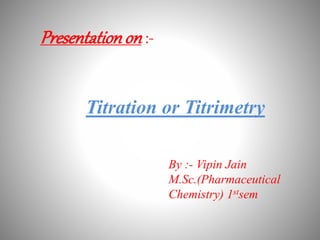
Titration Technique Guide Under 40 Characters
- 1. Presentationon :- Titration or Titrimetry By :- Vipin Jain M.Sc.(Pharmaceutical Chemistry) 1stsem
- 2. CONTENTS • Introduction • Principle of titration • Terms used in titration • Concentration Terms • Titrimetric calculation • Titrimetric apparatus • Types of titration • Fields of use • Advantages of titration
- 3. Introduction:- A technique for determining the concentration of a solution by measuring the volume of one solution needed to completely react with another solution. Titration process involves addition of solution of known conc. from burette to the measured volume of analyte.
- 4. Principle of titration:- It is based on the complete chemical reaction between the analyte and the reagent (titrant) of known concentration. Analyte + Titrant → Product
- 5. Terms used in titration Analyte:- The solution of unknown concentration but known volume. Titrant:- The solution of known concentration.
- 6. Standard solution:- A solution of known concentration is called the standard solution. Types of standard solution:- 1) Primary standard:- It has certain properties:- (a)Extremely pure. (b)Highly stable. (c) Can be weighed easily. For e.g. Na2CO3, KHP
- 7. Secondary standard:- It has certain properties:- (a) Less pure than primary standard. (b) Less stable than primary standard. (c) Can not be weighed easily. For e.g. NaOH, HCl
- 8. Euivalence Point:- Point where the amount of two reactants are just equivalent . End point:- Point at which the reaction is observed to be complete, this point is usually observe with the help of indicator.
- 9. Indicator:- An auxiliary substance which helps in the usual detection of the completion of the titration process at the end point. For examples:- Methyl orange, Phenolphthalein, Cresol red, Thymol blue.
- 10. Concentration Terms:- The concentration of standard solutions (titrants) are generally expressed in units of either molarity (CM, or M) or normality (CN, or N). Molarity (M):-It is the number of moles of a solute per liter of solution.
- 11. Normality:- It is the gram equivalent weight of solute dissolved per litre of solution. Molality:- It is the number of moles of solute present in per kilogram of solvent.
- 12. Titrimetric calculation :- It is based on the following law of equivalence:- NaVa = NsVs or MaVa = MsVs Where, Na is the normality of analyte. Va is the volume of the analyte. Ns is the normality of standard solution. Vs is the volume of standard solution used. Ma is the molarity of analyte. Ms is the molarity of standard solution.
- 14. Types of titration:- 1.Acid-base titrations 2.Complexometric titrations 3.Redox titrations 4.Precipitation titrations
- 15. Acid – base Titration( neutralization):-A sample of unknown concentration of acid is estimated with a known concentrated base or vice-verse. acid + base → water + salt HCl + NaOH ------> H2O + NaCl
- 16. Titrimetric curve and types of acid - base titration:- Titration curve:-A titration curve is a graph of the pH as a function of the amount of titrant (acid or base) added.
- 17. Titration curves for strong acid v strong base:-
- 18. Titration curves for strong acid v weak base:-
- 19. Titration curves for weak acid v strong base:-
- 20. Titration curves for weak acid v weak base:-
- 21. Complexometric Titrations:- As the name indicates, the end point is seems by formation of a complex molecule. Here titrant and titrand react to form a complex till end point is reached. Once complex is formed, the complex is stable and not further reaction takes place. Ca+2 + EDTA-4 ------> CaEDTA-2 Mg In + EDTA-4 ------> MgEDTA-2 + In-2
- 22. Redox titration:- Redox titration is based on the redox reaction (oxidation-reduction) between analyte and titrant. For example:- 6 Fe2+ + 14 H+ + Cr2O7 2- => 6 Fe3+ + 2Cr3+ + 7 H2O MnO4 - + 8 H+ + 5 Fe2+==>Mn2+ + 5 Fe3+ + 4 H2O
- 23. Precipitation titrations:- The titrations which are based on the formation of insoluble precipitates, when the solutions of two reacting substances are brought in contact with each other, are called Precipitation titration. Ag+(aq)+Cl−(aq)⇌AgCl(s)
- 24. Methods of precipitation titration:- Mohr ‘s method:- It involve formation of colored precipitate at the end point . Volhard ‘s method:- It involves formation of soluble colored complex at the end point. Fajan’s method:- It involves adsorption of a colored indicator on the precipitate at the end point.
- 25. Fields of use:- Titration is a widely applied analytical technique. Some areas where titration is used are given below:- Agriculture, Oil Industry, Chemical industry, Pharmaceuticals, Food Industry.
- 26. Advantages of titration :- There are several reasons why titration is used in laboratories worldwide:- 1)Titration is an established analytical technique. 2)It is fast .
- 27. 3) It is a very accurate and precise technique. 4) Titration offers a good price/performance ratio as compared to more sophisticated techniques. 6) It can be used by low-skilled and low- trained operators. 7) No need for highly specialized chemical knowledge.